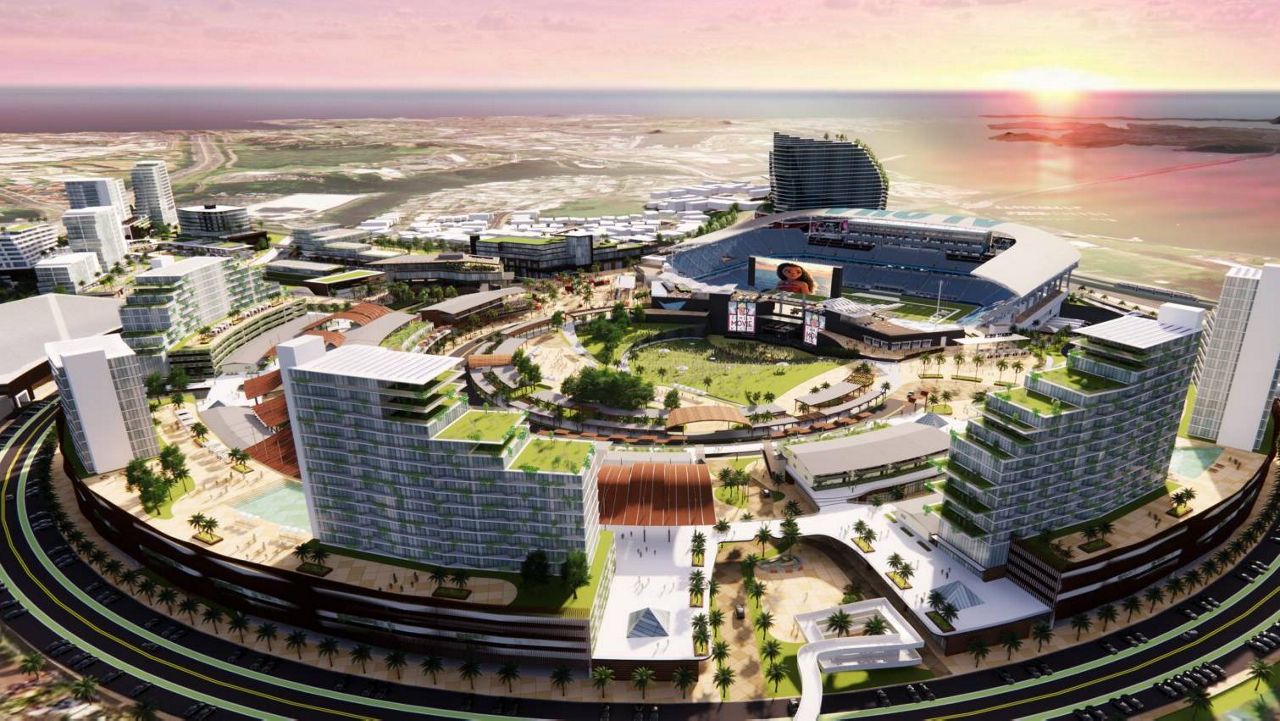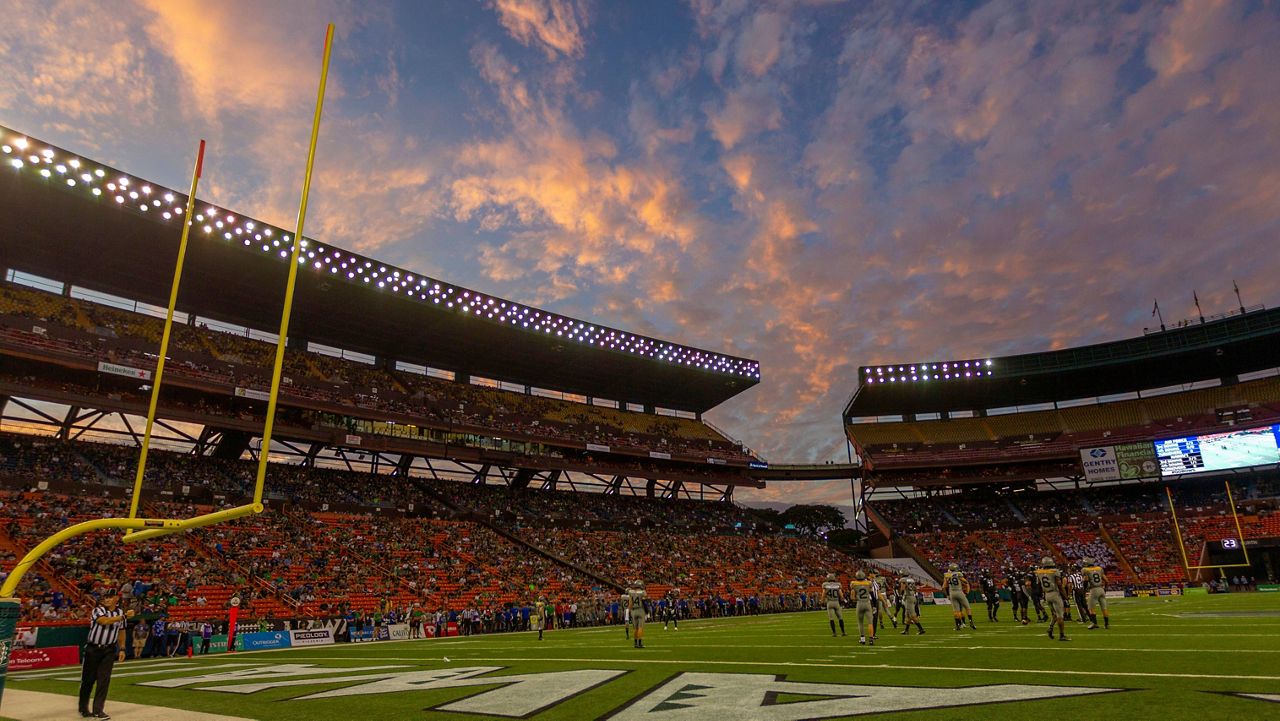HONOLULU — The future of a new stadium in Halawa is at a critical juncture given unforeseen cost variables that have altered and delayed the structure’s request for proposals process, Spectrum News has learned.
“We’ve got to act now. This is the time to act, or this is the time to pause, frankly,” state Department of Accounting and General Services Comptroller Curt Otaguro said in a phone call Tuesday. “I think we’re at that point to make that decision, for us to decide how to proceed.
“We’re at the crossroads,” he added, saying alternative mixed-use ideas that have cropped up for the 98-acre Aloha Stadium lot, such as affordable housing, have the potential to take the stadium project “off track.” Changes to the envisioned size and shape and pandemic-related rises in costs have caused multiple delays to the project.
While the New Aloha Stadium Entertainment District Project announced Monday the next phase for its request for proposals, or RFP, on the project's other side, the real estate and mixed-use district component, conspicuously absent was mention of an RFP for the new stadium itself, causing consternation for state Sen. Glenn Wakai, whose purview includes Halawa.
“I’m totally frustrated by where we are,” Wakai told Spectrum News. “The Legislature did its part; it provided the process in which to develop the area. It provided the funds; we assured them the rest of the funds would be appropriated this year. And we’re getting no response message from the (Gov. David Ige) administration that they’re part of the team and want to take this entire project down the field.”
The state is allocating $170 million toward the stadium project, with another $180 million possible.
The prospect of having to borrow private money, should the remaining amount of the originally promised $350 million not come through, has been a factor in delays, Otaguro said.
“We’ve gotten a verbal commitment, but it’s just that – a verbal commitment,” Otaguro said. “It’s not in law yet. So that does present some concern for (the state department of) Budget and Finance, and rightfully so.”
Otaguro said the stadium RFP is in “final review” with Budget and Finance. He said he plans to meet with Ige and staff later this week on the matter.
The stadium RFP was intended to be issued by the middle, and later, end of 2021. Now, if all goes well, the RFP could be issued within the next month, Otaguro said. The three development teams in consideration – Aloha Stadium District Partners, Aloha Stadium Hui Hilina‘i, and Waiola Development Partners – would have several more months to make a “Shark Tank” style pitch for what the stadium could look like in reality, with plans to construct, finance and maintain the facility.
Given ever-rising costs amid supply chain issues of the pandemic, some of the originally envisioned features of the new stadium have been reconsidered, Otaguro said.
“We took a hard look after we dreamed big in 2018 and 2019,” he said. “We wanted a 35,000-seat stadium, we wanted this and that. We were basically a kid in a candy store dreaming, ‘Wow, OK, let’s do this thing.’ But fortunately or unfortunately, the pandemic did put a stop to the dreaming, and (gave) a dose of reality. And so, in the current RFP plan – and again, these are just concepts – we’ve had to scale back some of the dream.”
That could mean a seating capacity in the 28,500 to 30,000 range and a straight roof instead of a curved one.
“(It’s time) for developers to roll up their sleeves, take the concepts that we drew up, even the size and shape of the stadium, and put their best foot forward competitively to see what, really, would work in reality,” Otaguro said. “The supply chain issues, all the things that are current and into the future, (affect) things we need to find out as a state. Only then, can we truly determine, ‘OK, this is something we can afford, we were right on mark, let’s go.’ Or, I hate to say it, but it might be, ‘whoa, we’re way off, we didn’t anticipate costs being so high.’”

On the upside, he said, the two development teams that were named Monday for the real estate portion of NASED are two of the three finalists for the stadium portion, which works well for continuity.
They are Aloha Halawa District Partners (comprised of Development Ventures Group Inc., Stanford Carr Development LLC, Hawaiian Dredging Construction Company Inc., WATG, SB Architects, Rebound Associates, Colliers, Wilson Okamoto Corporation, NBBJ LP, DTL, and Bennet Group) and Waiola Mixed-use Partners (comprised of Kobayashi Group, BSC Acquisitions II LLC, Machete Group Inc., Design Partners Inc., Manica Architecture, Stantec, Nan Inc., A.C. Kobayashi, JMA Ventures LLC, BAMP Project, Biederman Redevelopment Ventures, SSFM International, Wilson Okamoto Corporation, Nainoa Thompson, and S.H.A.D.E.)
“The two developer-led teams represent decades of experience in Hawaii’s construction industry and have the proven ability to execute the vision for the NASED Real Estate Project that has been shared with us by members of the community,” said Chris Kinimaka, public works administrator for DAGS, in Monday’s announcement. “We’ve heard from the community that NASED needs to be a true live-work-play-thrive entertainment district that will reinvigorate the area and become a beacon of community pride on game days and throughout the year.”
As part of Monday’s news release, NASED said the stadium RFP will be “issued in 2022” with on-site construction to commence in 2023. Original plans called for the new stadium to be completed in late 2023.
Meanwhile, the University of Hawaii, a primary tenant of 48-year-old Aloha Stadium, has had to shift its games to campus for the foreseeable future. The Stadium Authority declared a moratorium on future events for the deteriorating venue following the 2020 UH football season.
University of Hawaii Athletic Director David Matlin said during a conference call with media last month that getting the state to move ahead with a new stadium is of paramount importance for the UH football program.
UH played the 2021 season in the 9,000-seat Clarence T.C. Ching Athletics Complex, which could be expanded to about 15,000 seats in the coming years.
Spectrum News asked Wakai if it is possible that no stadium ever gets built and that UH would have to play on campus in perpetuity.
“I think anything is a possibility,” Wakai said. “We’ve seen government in the past stumble and bumble, and we’re doing it again. And it’s frustrating. I understand the public’s angst and disbelief, and lack of belief that the government can pull this off.”
